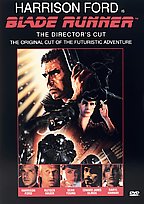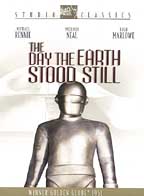Eternity in Their Hearts
I saw “Blade Runner” for the first time in the past year. The DVD was handed to me by a friend of ours who said it was one of his all-time favourite movies. That friend has been in the hospital this week in serious condition awaiting surgery for a chronic debilitating condition that causes him much pain. He has been living in his own waking nightmare for the last few months, seemingly with no hope of escape. Purportedly, the physical defect that causes him such pain and misery cannot be fixed. When you see someone suffer and perhaps even die from an “incurable” disease at such a young age, something in you cries out and says, “It’s not fair! This is not how it’s supposed to be!”
 I was very blessed to have only seen the Director’s Cut of the movie “Blade Runner”. The Interviews on TVO gave me some ideas of what the original 1982 version of the film was like with all of its hokie add-ons still intact. After being exposed to the Director’s Cut of the film initially, those add-ons looked like, well, like bad afterthoughts, which they probably were – the monotone Harrison Ford commentary and the sunshiney “happy ending”.
I was very blessed to have only seen the Director’s Cut of the movie “Blade Runner”. The Interviews on TVO gave me some ideas of what the original 1982 version of the film was like with all of its hokie add-ons still intact. After being exposed to the Director’s Cut of the film initially, those add-ons looked like, well, like bad afterthoughts, which they probably were – the monotone Harrison Ford commentary and the sunshiney “happy ending”.
The first time around I had problems really getting into the film. It is so dreary, so dissonant and so disorienting. It is not that easy to follow what is really going on. I tried to walk away from the film several times saying “I have better things to do with my time” only to find that it was really getting under my skin. Like it or not, I had to find out what happened to these strange outerworld characters and their even stranger real world counterparts. (I mean, the replicants have an excuse for being more than a bit off-base because they aren’t even human, but as for the “real” people, well, they are just strange. I guess we can blame it on the effects of too much smog and chronic overcrowding???)
And what happens as the story unfolds is ever stranger. As Deckard goes about his business of eliminating the “skin jobs” as a kind of ultimate cyber bounty hunter, we become more familiar with the “plight” of the replicants. It seemed to me that, at the same time as the action escalates and intensifies as the replicants get knocked off one by one, they also become progressively more sympathetic characters. It is a strange blend of escalating horror  and empathy. I can’t admit to being too emotionally involved when “Leon Kowalski” gets turfed. Zhora’s demise is portrayed a bit more sympathetically, intentionally so, according to Joanna Cassidy during the Intervews. The death of Pris, the ‘pleasure model’, is fully emotionally realized in terms of simultaneous tragedy and horror. Rutger Hauer as Roy brings home a riveting performance in his final minutes as the warrior poet atop a rain-soaked building. Neither we nor the beaten and cowering Deckard quite know what to make of Roy in his final soliloquy. It is so unexpected in every sense of the word.
and empathy. I can’t admit to being too emotionally involved when “Leon Kowalski” gets turfed. Zhora’s demise is portrayed a bit more sympathetically, intentionally so, according to Joanna Cassidy during the Intervews. The death of Pris, the ‘pleasure model’, is fully emotionally realized in terms of simultaneous tragedy and horror. Rutger Hauer as Roy brings home a riveting performance in his final minutes as the warrior poet atop a rain-soaked building. Neither we nor the beaten and cowering Deckard quite know what to make of Roy in his final soliloquy. It is so unexpected in every sense of the word.
 By the time Deckard gets back to the last replicant, Rachael, who is waiting at his apartment, the emotional tension is unbearable. As Deckard slowly draws back the sheet to reveal Rachael’s still form, it matters to us very much whether she is alive or dead. Whether she is, in fact, a machine or fully human as she so desperately wants to believe herself to be, we want her to live. Deckard’s emotions and will and ours reshape reality.
By the time Deckard gets back to the last replicant, Rachael, who is waiting at his apartment, the emotional tension is unbearable. As Deckard slowly draws back the sheet to reveal Rachael’s still form, it matters to us very much whether she is alive or dead. Whether she is, in fact, a machine or fully human as she so desperately wants to believe herself to be, we want her to live. Deckard’s emotions and will and ours reshape reality.
The ambiguity created by Ridley Scott for me serves to bring out rather than bury certain important themes in the film such as the essence of being human, the quest for immortality, the fundamental human need for love and meaning, the ephemeral nature of memory, and freedom as an ‘inalienable’ human right. The postmodern fascination with eternal ambiguities and redefinitions of truth and reality makes this a difficult film to view for some, but it also renders the film more interesting on a second, third, and fourth viewing. Perhaps it is this postmodern sensibility that made the film inaccessible for the popular audience when it was first brought to the screen in 1982. However, this same “sensibility” accounts for its increasing reputation and cult following as the years have passed. More people are more comfortable with the vision of the world that Ridley conveys in this film because it has more in common with the ways in which the majority now experience life. It was a film that was “before its time”.
I am glad that I missed the film in 1982. I wouldn’t have been ready for it. The queer mixture of cyberpunk and 1940’s film noir would have been too jarring a juxtaposition for me. With distance and a bit more maturity, I can see where the film has something to say as well as an artful manner of saying it. I can’t really say that I “liked” the film, but I can admit to appreciating it in that uncomfortable “get under your skin” kind of way.
 My kids liked the first flick, “The Day the Earth Stood Still”. My son told me very proudly the next day that he had not had a nightmare as a result of watching the movie. I think that maybe he has watched that “George Shrinks” episode (or maybe it was “Miss B.G.”) one too many times where George gets himself into trouble after too much pizza and altogether too silly scary sci-fi movies.
My kids liked the first flick, “The Day the Earth Stood Still”. My son told me very proudly the next day that he had not had a nightmare as a result of watching the movie. I think that maybe he has watched that “George Shrinks” episode (or maybe it was “Miss B.G.”) one too many times where George gets himself into trouble after too much pizza and altogether too silly scary sci-fi movies.
My kids didn’t mind the low-tech special effects (a man in a rubber suit for a robot and a rollout runway from the flying saucer). Now I know that the available technology and the budget were somewhat more limited for this film when compared with something like “Blade Runner”, but really! Fortunately for this film, things are much easier on the make-up department than they could have been since much of the action has the main character, the alien Klaatu, running around Washington dressed as a normal circa 1950 human being.
The film has more to say about the atmosphere in post-war America than about any atmospheric conditions on a faraway planet. The United Nations is depicted as an ineffectual agency for maintaining global peace and world order in spite of the pressing need to pursue such a goal. Things haven’t changed much on earth in half a century. One cold war and many regional wars later, world peace is just as elusive as it was in 1950. The U.N. seems just as ineffective today as it was then. Communications and technology may have advanced by leaps and bounds over the intervening decades, but it appears that we are stuck with the same essential problems as human beings when it comes to getting along with each other.
“Get it together and stop the fighting!” says Klaatu in ominous tones, “Or else you will be vaporized as a planet endangering the universal peace and equilibrium.” And Klaatu has a scary robot to back up his warnings.
Sometimes as a parent with constantly squabbling offspring underfoot, I wish I could pull out a big scary robot with laser beams hidden under his visor as a deterrent. Threats of vaporization might work nicely in order to maintain household peace and stability. But then again, maybe not. It might work for a while, but then the kids would find out that it was just an ordinary guy in a rubber suit or that they were not really going to be terminated immediately. If only it were so easy to get them to change their behaviour! No, I guess I will have to wait for a better approach. In the meantime, since I am not really willing to vaporize my offspring, I guess I have to put up with an awful lot of squabbling.
On May 27th on SNATM at 8pm EST on TVOntario, catch John Wayne doing his cowboy thing in “The Searchers” followed by Dustin Hoffman as “Little Big Man”.
Suggested Reading:
- No camera tricks here! Gort the robot really was that tall in “The Day the Earth Stood Still”. See IMDb
- Eternity in their hearts: Context please.
- Can people really change? “I wanted to be one of the freest people in the whole world,” Josh McDowell’s seldom heard story.
- Peace in war-torn Rwanda: a personal journey
- The Day of Reckoning: “My friend drew one unforgettable word on the computer screen – Die.”
- So what’s the point? Life after life
blade+runnerthe+day+the+earth+stood+ still